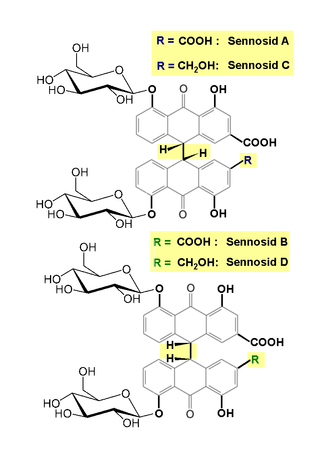Top Qs
Timeline
Chat
Perspective
Senna glycoside
Constipation and surgery medication From Wikipedia, the free encyclopedia
Remove ads
Senna glycoside, also known as sennoside or senna, is a medication used to treat constipation and empty the large intestine before surgery.[1][5] The medication is taken orally (swallowed by mouth) or via the rectum.[1][6] It typically begins working in around 30 minutes when given by rectum and within twelve hours when given orally.[3] It is a weaker laxative than bisacodyl and castor oil.[1]
Common side effects of senna glycoside include abdominal cramps.[3] It is not recommended for long-term use, as it may result in poor bowel function or electrolyte problems.[1] While no harm has been found to result from use while breastfeeding, such use is not typically recommended.[1] It is not typically recommended in children.[1] Senna may change urine to a somewhat reddish color.[1] Senna derivatives are a type of stimulant laxative and are of the anthraquinone type.[1] While its mechanism of action is not entirely clear, senna is thought to act by increasing fluid secretion within and contraction of the large intestine.[1]
Sennosides come from the group of plants Senna.[3] In plant form, it has been used at least since the 700s AD.[7] It is on the World Health Organization's List of Essential Medicines.[8] It is available as a generic medication.[1][6] In 2023, it was the 302nd most commonly prescribed medication in the United States, with more than 300,000 prescriptions.[9] In 2023, the combination with docusate was the 242nd most commonly prescribed medication in the United States, with more than 1 million prescriptions.[10][11] It is sold under a number of brand names including Ex-Lax and Senokot.[1]
Remove ads
Medical uses
Senna is used for episodic and chronic constipation though there is a lack of high-quality evidence to support its use for these purposes.[5] It may also be used to aid in the evacuation of the bowel prior to surgery or invasive rectal or colonic examinations.[12][13]
Administration
Oral senna products typically produce a bowel movement in 6 to 12 hours. Rectal suppositories can act within minutes or take up to two hours.[14]
Remove ads
Contraindications
According to Commission E, senna is contraindicated in cases of intestinal obstruction, acute intestinal inflammation (e.g., Crohn's disease), ulcerative colitis, appendicitis, and abdominal pain of unknown origin.[12]
Senna is considered contraindicated in people with a documented allergy to anthraquinones. Such allergies are rare and typically limited to dermatological reactions of redness and itching.[12]
Remove ads
Adverse effects
Adverse effects are typically limited to gastrointestinal reactions and include abdominal pain or cramps, diarrhea, nausea, and vomiting.[12]
Regular use of senna products can lead to a characteristic brown pigmentation of the internal colonic wall seen on colonoscopy. This abnormal pigmentation is known as melanosis coli.[14]
Interactions
Senna glycosides can increase digoxin toxicity in patients taking digoxin by reducing serum potassium levels, thereby enhancing the effects of digoxin.[15]
Mechanism of action
The breakdown products of senna act directly as irritants on the colonic wall to induce fluid secretion and colonic motility.[16]
Pharmacology
They are anthraquinones derivatives and dimeric glycosides.[17]
Society and culture
Formulations
Senna is an over-the-counter drug available in multiple formulations, including oral formations (liquid, tablet, granular) and rectal suppositories. Senna products are manufactured by multiple generic drug makers and sold under various brand names.[13]
Brand names
Ex-Lax, Geri-kot, Perdiem Overnight Relief, Senexon, Pursennid, Senna Smooth, Senna-Gen, Senna-GRX, Senna-Lax, Senna-Tabs, Senna-Time, SennaCon, Senno, Senokot.[12]
Remove ads
References
Wikiwand - on
Seamless Wikipedia browsing. On steroids.
Remove ads

